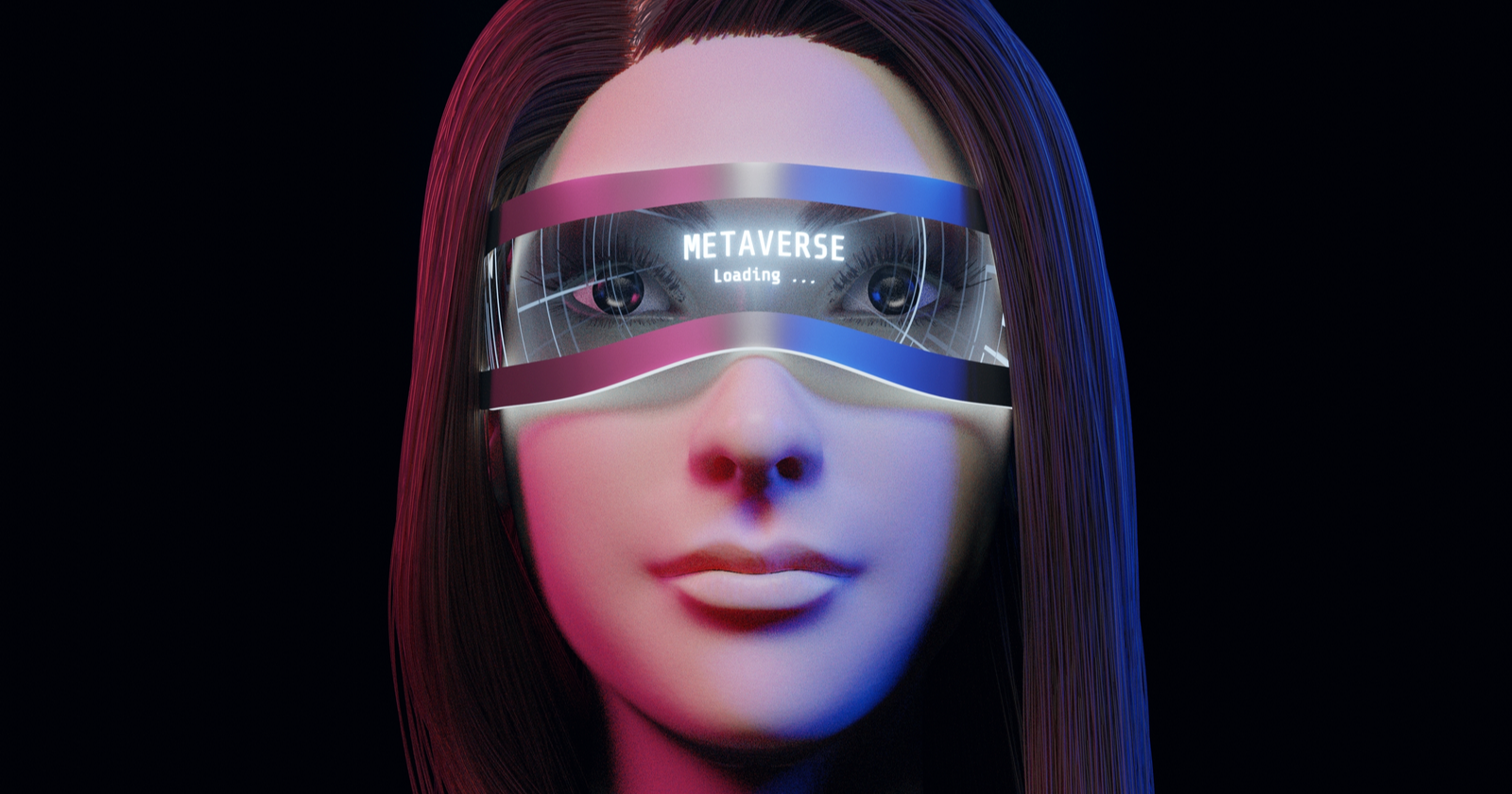When brands like JP Morgan, Nike, Playboy, Adidas, and McDonald’s enter the metaverse, do we all jump in?
Or are we already in, and we don’t even realize it?
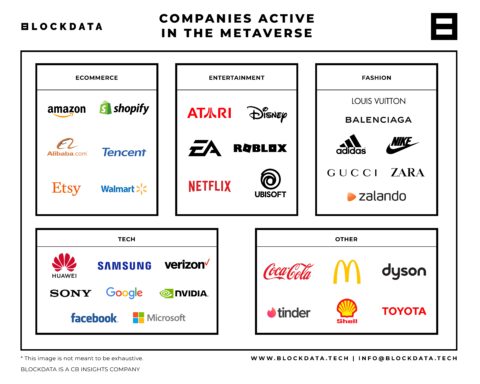 Image from Blockdata.tech, February 2022
Image from Blockdata.tech, February 2022Brands In The Metaverse
Probably nothing. Right?
Tell that to these brands who are
JP Morgan Is Banking On It
JP Morgan is the first bank to stake its claim in the metaverse by setting up a lounge in Decentraland, a 3D virtual world browser-based platform.
The banking brand’s lounge touts a monthly active user base of about 300,000 people and 18,000 daily users, according to Decentraland co-founder Ari Meilich in a recent interview.
In its report Opportunities in the Metaverse, JP Morgan highlighted:
“The metaverse is estimated to be a trillion-dollar revenue opportunity across advertising, social commerce, digital events, hardware, and developer/creator monetization.”
Nike Dips A Toe In The Metaverse
Nike created its metaverse studio back in June 2021 before the word metaverse became mainstream, thanks to Mark Zuckerberg announcing the Meta rebrand of Facebook last October.
The sportswear brand acquired RTFKT, a digital sneaker company enabling them to create NFT shoes.
The swoosh-famous company revealed NIKELAND, a virtual world modeled after its headquarters on video game platform Roblox Corp (RBLX.N), becoming one of the first big brands to enter the “metaverse.”
Playboy Is All Ears
The iconic lifestyle brand Playboy unveiled a collection of NFTs: Playboy Rabbitars.
They released 11,953 unique 3D rabbit characters in NFT form and sold out in three minutes.
Available on the Opensea marketplace, each NFT came with special perks such as a membership to the Playboy Club and other exclusive benefits.
NFTs Are No Monkey Business
In news that almost broke Twitter, Adidas announced INTO THE METAVERSE, an exclusive NFT drop of digital and physical products in collaboration with G Money, Pixel Vault, and the Bored Apes Yacht Club.
“These communities aren’t collecting hyped-up tokens, they have a stake in the future of that community, and I think we can learn something about that. When we think about the role that we can play as a brand to be that trusted friend of our members looking to join this space,” Tareq Nazlawy, Senior Director Digital at Adidas, said in a December announcement.
Big Macs Go Digital
Fries and a digital cheeseburger, please.
McDonald’s is preparing to open virtual restaurants serving up NFTs and offering home delivery from a virtual restaurant.
Defining The Metaverse + A Look Back In Time
In this revolutionary phase, no one can quite define the metaverse yet.
It is an evolving next phase of the Internet, and calling it Web 3.0 might be more accurate.
Let’s look at the evolution of media and tech in the Internet world.
-
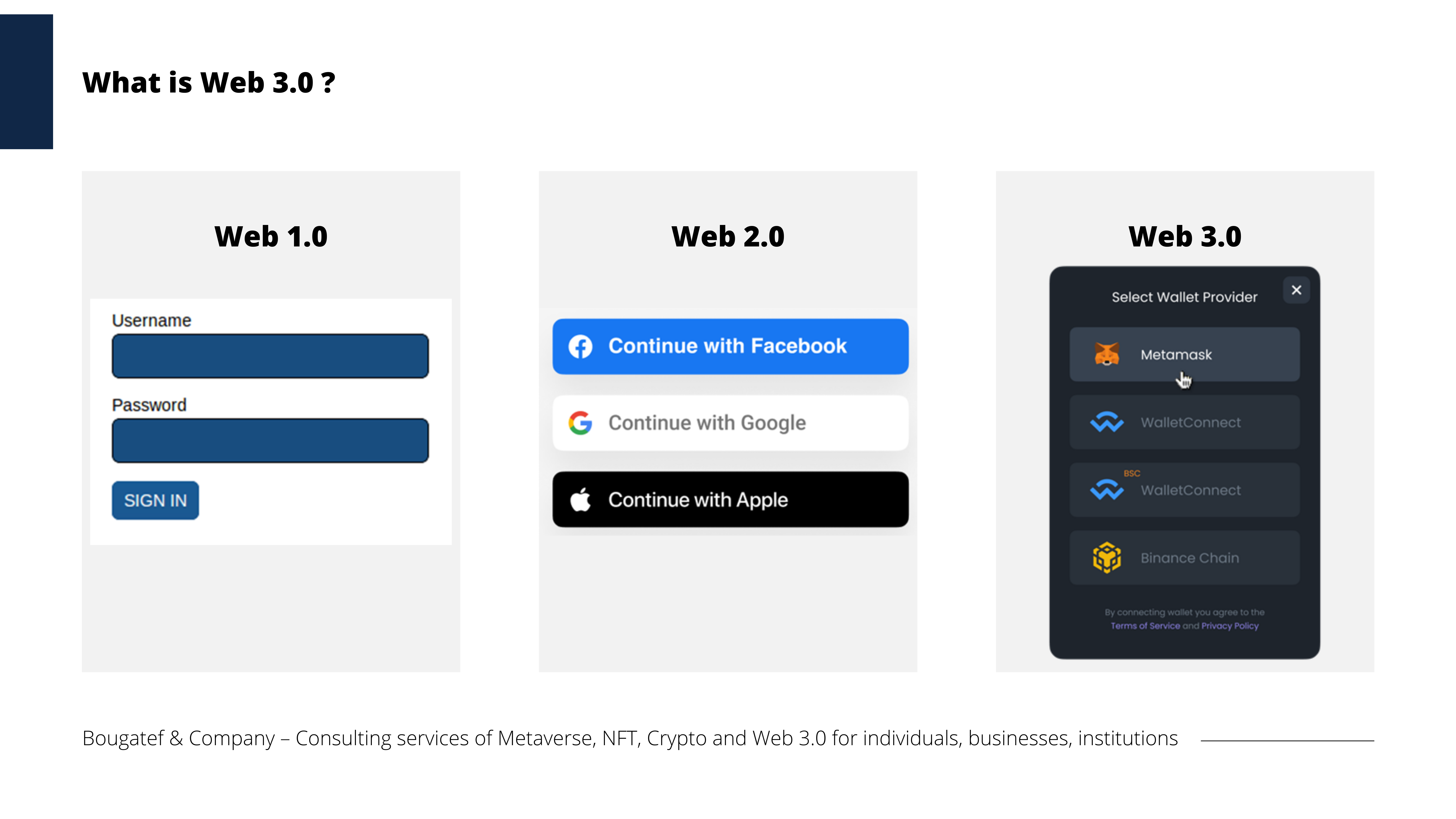 Image created by Zakarya Bougatef, February 2022
Image created by Zakarya Bougatef, February 2022
Web 1.0 Brands Say: What’s This Thing Called The Internet?
Do I need an email account and a website?
Web 1.0 dates back to the late 1990s and early 2000s. You know, back when businesses speculated whether they needed a website, and Google Search results consisted of links.
Think low bandwidth, forums, emails, and static HTML.
Pageviews mattered, and Internet purchases were not trusted and considered high risk.
Mobile phones were for the elite.
Web 2.0 Brands Say: Let The Interns Run Social Media, And Google Is My God
Web 2.0 transitioned and revolutionized all things digital in 2004-2016 to welcome social networking, ecommerce, mobile, video, sharing, and influence.
Cost per click mattered.
Facebook ruled, and SEO was king.
Influencer became a profession.
Everyone has a smartphone, and there’s an app for that. Bandwidths are higher.
Web 3.0 Brands Say: Facebook Is The Devil. What Happened To Organic? Is The Metaverse A Fad?
Web 3.0 emerged in 2016 with glimpses of futuristic technology such as virtual reality, augmented reality, artificial intelligence, and a new cryptocurrency called Bitcoin.
User engagement and community are now kings.
Creators are gaining power.
Today we are quickly entering a 3D world thanks to the pandemic escalating the adoption of AR, VR, and immersive worlds.
Facebook rebrands to Meta, pushing the term metaverse into headline news.
NFTs take on a life of their own.
Discord is the Soho of Web 3.0. Facebook Groups lose power.
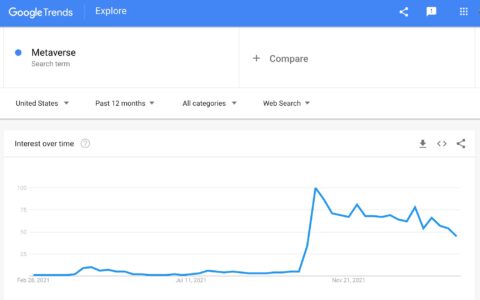 Image from Google Trends, February 2022
Image from Google Trends, February 2022Metaverse Myths And Musts
Since Zuckerberg’s announcement of Meta, the word “metaverse” has significantly spiked in Google Trends.
“NFT” Google searches hit an all-time high in January.
As digital marketers and brands scramble to wrap their brains and budget around a metaverse strategy, the early adoption stages carry the most risk and highest reward.
 Image from Google Trends, February 2022
Image from Google Trends, February 2022Keep in mind we are in the wild, wild west of Web 3.0; it’s hard to call anyone an expert.
Those with the advanced Web 3.0 experience have been “all-in” for six to 12 months.
Web 3.0 and metaverse experts have been involved in AR/VR or AI for the last decade.
They are the true experts of this next phase of digital marketing and the Internet; they influence how the metaverse evolves.
“We are moving from brand.com in the Web 1.0 era, to @brand in the Web 2.0 to era to now brand.eth in the Web 3.0 era,” said Cathy Hackl, a leading metaverse and Web 3.0 strategist.
“One thing I’ve learned from working in metaverse-related industries for over eight years now is that change is constant, acceleration is not slowing down, and the brands that understand new customer touchpoints and new customer journeys are being created today and truly understand how their brand DNA extends into the metaverse will be better positioned to stay relevant,” she said.
For Hackl, it’s key for any brand entering the space to have a holistic metaverse strategy including clear pilots and phases, and most importantly, clear OKRs (Objectives and Key Results).
For her, how we measured success in the Web 2.0 era does not necessarily translate in Web 3.
One metric she views as extremely important is dwell time, as the metaverse is about virtual shared experiences happening both in virtual worlds but also extend into the physical world.
Is The Metaverse The Same As Web 3.0?
“Web 3.0 and the Metaverse are intrinsically linked, but they are not the same thing,” added Hackl.
“Web 3.0 centers around how people, spaces (places) & assets (things) are connected in this new iteration of the internet, while the metaverse centers around how we will experience the future of the internet which is enabled by many different technologies,” she explained.
What“Experts” Advise On Myths To Be Aware Of & Musts To Know
Metaverse Myths
Myth: You Need A Well-Planned Roadmap
“This is not always true. In fact, the underpromising NFT projects tend to be more successful in Web 3.0. Promising too much on a roadmap can often fall flat if expectations are not met. Once that happens, it can sometimes be hard to recover from FUD (fear, uncertainty, doubt). If you underpromise and overdeliver, your NFT holders will be much happier,” said Emily Carrig, NFT Researcher, and Collector.
An example of a project that promised nothing is that of sartoshi_nft.
Sartoshi dropped the project with no team, no roadmap, and no discord.
This allowed the community to take over, and now the project is among the most successful of 2022, according to Carrig.
Myth: The Metaverse/Web 3.0 Is Completely New & Unlike Anything Marketers Have Previously Worked With
“It is not, particularly on the content side. While elements of Web 3.0, crypto, blockchain, NFTs ARE new and complicated, the transition to the metaverse to engage with consumers is a continuation of digital marketing and digital transformation.
“The same principles of connecting with an audience through storytelling are the same as any 2D media. The metaverse just offers exciting new opportunities to surprise and delight consumers and REALLY create community,” said Stefanie Smith – CMO of MetaVRse.
Myth: Meta (Formally Facebook) Is The Metaverse
Mark Zuckerberg did not create the metaverse and does not own the metaverse.
The metaverse is not one place or one organization.
Zuckerberg can take credit for taking the term metaverse and making it mainstream, bringing awareness to the Web 3.0 movement.
Myth: The Metaverse Has Arrived
“The biggest myth right now is that the metaverse has arrived. It’s not here yet, and it’s not ready for mainstream adoption. So if you’re a brand, it’s not too late to start planning your approach/figure out you will engage customers in the metaverse.
“Brands can’t just try and duplicate their Web 2.0 strategy – this is going to take a new team, new vision, and new approach,” said Mike Paffmann, CEO of Virgo PR.
Myth: The Metaverse Will Evolve At The Speed Of Consumer Behavior Change
“The truth is, it can only evolve at the speed of the network topology and computational power to support it, and which, at the moment, does not exist. The consensus of credible estimates suggests the need for 1,000x the computational power that currently exists.
“In a rush to understand the metaverse, one myth many brands have to understand is that you don’t have to use VR goggles or have an Oculus headset – users can access these 3D web experiences via their computer or smartphone,” said Michael Toner, CMO of Threedium.
Myth: The Metaverse Is A Bubble
“The fact that people think it’s a bubble that is going to explode someday, but it’s not: Metaverse is gonna be a part of our everyday life, especially with Apple Glass which will be very useful in real life
“Most today don’t understand why big brands join the Metaverse because they don’t understand the utility yet,” said Zakarya Bougatef, CEO of Bougatef & Company.
Myth: The Tech Around Web 3 Is The Cool Thing
“The cool thing is how people interact and bond socially within Web 3.0,” said Lauren Bigelow, Chief Product Officer at Together Labs.
Myth: “But I Can’t Touch It…”
“This is the most frequent argument I get when onboarding people into NFTs,” said Swan Sit, NFT/Web 3 Advisor and the creator Forbes dubbed “Queen of Clubhouse.”
“But if I deleted all your photos off your phone, you’d care, right? You can’t touch those either,” she said.
We need to evolve our thinking beyond what’s tangible and realize that the assets of the future will be both physical and digital, and equally valuable.
“NFTs are just art or cartoons…”
Yes, some are.
“But an NFT is anything that can be a digitized asset, so it could be land deeds, birth certificates, ticket stubs, medical records, certifications of education or employment, luxury goods certificates of authenticity – the list is endless. And that’s not even getting into the supply chain or customer data. NFTs are about to change how we live, work, and play,” Sit explained.
Metaverse Musts
Must: Web3 Is All About Putting Consumers First
“Consumers are in control of their data and assets. There are a lot of companies operating (dare I say masquerading) in Web 3.0 but are as Web 2.0 as they come – we’re still in transition.
“The true future of Web 3.0 puts the consumer first and in power. The quicker a brand or company realizes that the sooner they’ll win favor with the Web 3.0 community,” Sit said.
Must: The Promise Of The ‘Metaverse’ Is Really The Promise Of Web 3.0
Since Web 3.0 does not yet exist in a user-friendly form, brands and marketers must concentrate on the technologies, workflow, and processes that Web 2.1 is likely to include: Self-sovereign ID (SSID), decentralized identification (DID), Defi (crypto and dApps), and other emerging technologies that empower users to share in the value they create,” said Shelly Palmer, author and CEO of The Palmer Group and LinkedIn’s Top Voice in Technology.
Must: Long-term Brand Experience You Can Create For Your Community Through These Decentralized Platforms
“One thing brands must get right is the long-term brand experience that you can create for your community through these decentralized platforms.
“Brands that find success in the metaverse are creating incredible ways to blend the virtual experience with the physical world,” said Toner.
Must: Community Is The Commodity In Web 3.0
Brands must get to know their potential collectors and build their Web 3.0 community.
“I see too many brands coming in who think they can drop a project and be successful without putting the work in to build a community around their brand. Develop your presence in the Web 3.0 space and get involved in the other NFT communities before launching a project.
“Learn about what additional NFT communities value. Start hosting Twitter Spaces related to Web 3.0 and see what kind of feedback you get. You will probably learn a lot while also building your community. Without attempting to do these things, your project may look like a cash grab and fall flat,” said Carrig.
Must: Continue To Ask Yourself, “What If?”
“What if many of my users already play mobile or online social games? What if NFTs are more than just JPEGs for trading? What if we allowed our users to help co-create our footprint in Web 3.0?
“What if you didn’t wait for the other brand in your category to move first?” said Reid Litman, Global Consultant, Ogilvy Growth & Innovation.
Must: Every Brand Should Be On Twitter Spaces
Take a break from Facebook and Instagram: Learn as much as you can in 2022, leveraging Twitter Spaces and Discord communities with like-minded audiences.
Must: Creators And Community Lead, Brands Enable
This advice comes from Krys Burnette, an Organization and Culture Transformation Leader who helps Fortune 500 companies, including Adidas, in digital transformation and culture.
Must: Brands In The Metaverse Must Be Authentic
“Marketers make sure you authentically integrate your brand into the metaverse – the more it’s a natural part of the immersive experience the better,” said Bigelow.
Must: Try New Things And Experiment. Build An Audience First
For a creator to succeed with Web 3.0, build an audience first. From that audience comes real community. From the community, you can deliver a token experience that is a win/win for everyone,” said Joe Pulizzi, founder at The Tilt and co-founder of CEX: Creator Economy Expo.
Pulizzi launched his creator coin in March 2021, and it sits at the #1 spot on Rally.io’s list of creator coins. “We now have over 1,700 coin holders and almost 1,000 people on our discord channel,” he said.
“We are in a major experimentation phase with Web3. That means we practice, try new things, and experiment. Today’s models are not tomorrow’s. Think Internet the late 90s. Who knew where it would go?”
Must: Think In A PR 3.0 Mindset
While many public relations professionals are still stuck in a traditional pre-web or Web 1.0 mentality, some have bridged over to embracing Web 2.0 into the public relations strategy.
The public relations pros, freelancers, publicists, PR agency owners, and PR strategists who ignore Web 3.0 will be quickly irrelevant.
Brands hiring PR talent need to be aware of this transformation and do their due diligence before investing in a program.
Why Create, Sell Or Buy NFTs?
The question is now, “What’s in your wallet?”
NFTs – although they can also be a JPEG or a GIF, PNG, Video, Music, or any verifiable digital asset – are so much more than a JPEG.
NFTs are predicted to be the most authentic form of self-expression in some ways replacing social media posts.
Brands are creating and buying NFTs to generate community and join the community.
More than art, NFTs can come with a utility. For example, a restaurant can sell NFTs, and owners of the NFT get perks such as reservation priority.
NFTs such as Bored Ape Yacht Club and Boss Beauties come with access to the other collection owners and a tight-knit like-minded aligned community.
Think of it like a digital country club, women’s power club, or even a mental health garden club.
NFTs go beyond art, as they have a place across:
- Real Estate.
- Legal Contracts.
- Medical Records.
- Identity Verification.
- Intellectual Property and Patents.
- Supply Chain.
- Gaming Industry.
- Voting.
- Ticketing.
- Metaverse Avatars.
- And more – this is just the beginning.
- Domains – it’s a whole new world.
It used to be all the power was in the .com domain.
Today in Web 3 .ETH, .NFT are personalizing the user experience.
A Web 3.0 domain is a human-readable address that stands for your crypto wallet.
A 42-character hex string becomes something like Paris Hilton.ETH.
When someone wants to send Paris ETH, they can remember that much shorter phrase as her wallet address.
According to Unstoppable Domains, Web 3.0 is a movement to reclaim the internet.
It isn’t one single technology or advancement but a complete rethinking of how the web should work.
Crypto Craze – Is it Safe And Secure?
There was a not-so-distant time when people were afraid of ATM cards and did not trust using a credit card on the Internet.
Early adoption will always be easy prey for scammers.
Some tips to avoid getting scammed in crypto:
- Start slow with small amounts.
- Don’t store everything in a hot wallet.
- Get a hardware waller.
- Never share your seed phrase.
- Ignore all DMs on Discord.
- When in doubt, cross-reference everything.
It is easy to get intimidated, frustrated, and ignore the hassle of trying to figure out the red tape of getting started in crypto.
But experts agree that the thing to remember is to start slow and don’t give up.
Once you get past the initial set-up and beginner phase, it does get easier.
Women Make Bold Moves
 Author Lisa Buyer and sources in the story Cathy Hackl and Krys Burnette illustrate their Boss Beauties NFT also used as profile picture.
Author Lisa Buyer and sources in the story Cathy Hackl and Krys Burnette illustrate their Boss Beauties NFT also used as profile picture.- Women have always played a minority role in tech.
As Web 3.0 emerges, more women are leaning into the space.
Celebrities including Reese Witherspoon, Eva Longoria, and Paris Hilton are raising the bar by investing in women-led NFT projects, creating virtual worlds, and bonding like never before in history.
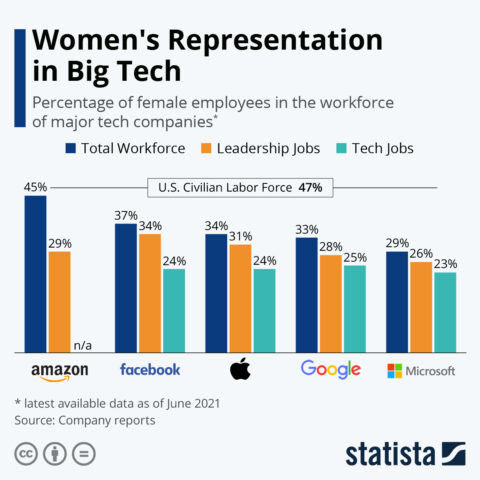 Image from Statista, February 2022
Image from Statista, February 2022Influencer Randi Zuckerberg just launched the community Hugz, dedicated to helping Web 3.0 creators. Zuckerberg, Hackl and Sit are all helping break digital ceilings and dismantle the “boys club of tech.”
BFF also launched this year, founded by 50 leading women including Gwyneth Paltrow, Tyra Banks, and Hackl as a female-forward community to learn crypto, NFTs, Web 3.0 together.
Blue-chip labeled women-led NFT collections, including World of Women and Boss Beauties, give mostly male-dominated Bored Ape Yacht Club NFT collection a run for their ETH.
LDR Ventures, a Venture Capital Investment Firm, is focused on investing and supporting women-led companies, especially those focused on Web 3.0 and female NFT artists says C0-Managing Director Maxine Kozler Koven.
Community Terminology
Jumping into the metaverse world of NFTs and crypto on Twitter might seem slightly intimidating and foreign. It’s essential to know the terminology in order to translate and fit in.
- NFT: Non-Fungible Token.
- GM/GN: Good Morning/Goodnight.
- WAGMI: We Are All Gonna Make It.
- PFP: an acronym in texting and social media. It means both pictures for proof and profile pic. You can’t help but notice the takeover of profile pics to NFTs. For example, Witherspoon changed her Twitter profile to represent her Boss Beauties NFT.
- Mint: the act of initially issuing a piece of art on the blockchain.
- Probably Nothing: this is sarcastic, meaning probably a big deal.
Metaverse Resources To Learn
According to the JP Morgan report, the asymmetrical risk of being left behind is worth the incremental investment needed to get started and explore this new digital landscape for yourself.
Your Digital Wallet Is My Command?
The metaverse is not magic or voodoo.
It’s a blend of digital and physical world colliding, from lounges to digital fashion and food to membership to physical goods.
One thing is for sure – the metaverse is a marketing reality.
All aboard! GN.
More resources:
Featured Image: kkssr/Shutterstock
